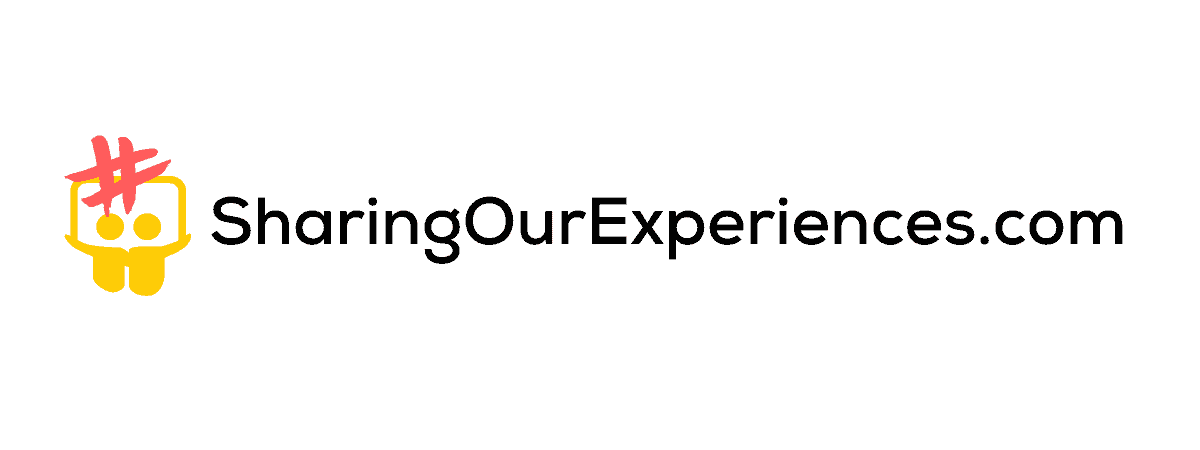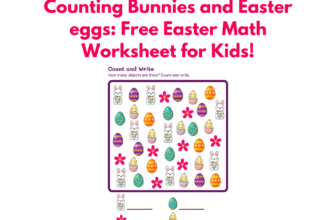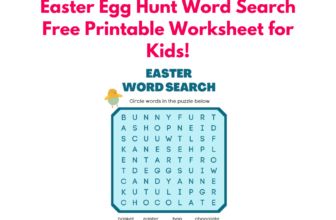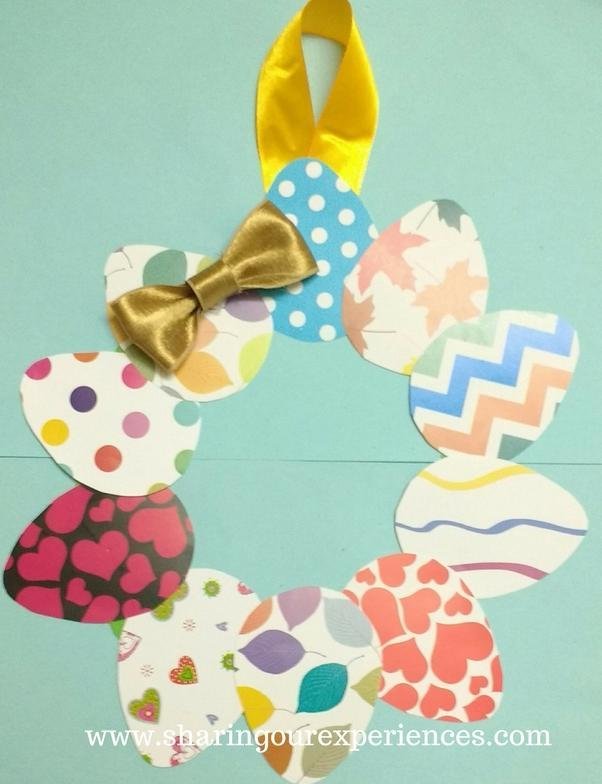
Why do we celebrate Easter. What is Easter. How to explain Easter to kids. What is the connection between eggs, bunny and Easter. I always used to wonder about these questions. So here in this article I will be answering most of these along with some fun Easter facts for kids and activities and games they can play on Easter.
Also Read – Easter Egg Hunt Word Search: A Fun and Free Printable Worksheet for Kids!
Counting Bunnies and Easter eggs: Free Easter Math Worksheet for Kids!
Also Read – Top 25 Adorable Easter Basket Ideas for Toddlers in 2023: Fun and Creative Picks
10 facts about Easter
- Easter is a Christian holiday that celebrates the resurrection of Jesus Christ from the dead, which is said to have occurred on the third day after his crucifixion.
- The date of Easter varies from year to year, but it is always celebrated on the first Sunday after the first full moon that occurs on or after the vernal equinox (around March 21).
- The word “Easter” is thought to have come from the Old English word “Ä“astre,” which was the name of a pagan festival celebrating the spring equinox.
- Easter eggs are a traditional symbol of the holiday, representing new life and rebirth. The practice of coloring and decorating eggs dates back to ancient times.
- The Easter bunny is also a popular symbol of the holiday, and is said to bring baskets of candy and treats to children.
- Hot cross buns, a type of sweet roll with a cross on top, are a traditional food eaten during the Easter season.
- In many countries, Easter Monday is also a public holiday.
- The week leading up to Easter is known as Holy Week and includes important events such as Palm Sunday, Maundy Thursday, Good Friday, and Easter Sunday.
- Easter is the oldest and most important Christian holiday, and is celebrated by millions of people around the world.
- In addition to its religious significance, Easter is also associated with the beginning of spring and is a time of new beginnings, renewal, and hope.
What is Easter
Easter is a Christian Holiday celebrated as the day of Jesus Christ’s resurrection.
When is Easter Celebrated
The date of Easter celebration changes every year.
Easter is celebrated on first Sunday after the first full moon following the spring equinox (equinox happens twice a year. its the date or time when day and night are of equal length.
This always occurs on or between 22 March and 25th April.
Why do we celebrate Easter
On Easter Sunday, the Christian community celebrates the renaissance of the lord, Jesus Christ. It is believed in Christians that Jesus Christ was reborn three days after Jesus was crucified by the Romans on the cross
It consists of a series of events and holidays that begins
- 40-day period of Lent – the time of fasting, prayer and sacrifices which begins on Ash Wednesday.
- week before Easter is known as Holy week – includes the celebration of Jesus last supper with his 12 Apostles known as Holy Thursday, Good Friday– day when Jesus was crucified and Holy Saturday (time between crucifixion and resurrection)
- and then Easter Sunday– the day when Jesus raised from dead.
Why is Easter important
Easter is a very noteworthy date on the Christian calendar. In the Bibles New Testament, the renaissance of Jesus is defined as the basically the foundation stone for the Christianity.
As per the New Testament, The Roman authorities arrested Jesus as he claimed that he was the God’s son, due to this some say Romans thought him to be potential threat to the Roman Empire. As per the authors of the gospels, rebirth of Jesus was the proof that he was the son of God.
Easter in the most important Christian festival and it is celebrated with joy by all 🙂
How do we celebrate Easter
Many Christians spend time in church in thought, in prayer and in celebration of Jesus Christ’s life and resurrection. They get together for a special meal together with friends and family.
Easter is celebrated around the world with special church services, music, flowers, ringing of church bells, exchanging gifts, Easter baskets.
What are the other traditions and games associated with Easter
- Easter egg hunts – its a game in which kids search for hard boiled eggs that are painted or decorated, artificial eggs, or egg shaped chocolates or candies usually outdoors and put what they find in their basket. After the hunt is over prizes are given to kids
- Easter egg roll – a game played with hard boiled decorated eggs. There are different version across countries, but mainly the hard boiled decorated Easter eggs are rolled. It could be a race or a game n which whose egg remains unbroken wins
- Ester bunny giving Easter gift baskets to kids (even adults at times). Easter baskets are mainly baskets of toys, gifts, decorated eggs, chocolate eggs, chocolate Easter bunnies and candies for the kids.
Why is Easter named so
The work Easter comes from the word Ä’osturmÅnaþ meaning Easter month – old name for month of April. which in turn was named after Ä’ostre – pre-christian Goddess in England who was celebrated in month of spring.
One thought is Easter was originally a pagan festival celebrating the beginning of spring. The festival focused on fertility and used rabbits and eggs as symbols. Early Christians adopted the festival to celebrate the resurrection of Christ.
Where does the tradition of Easter eggs come about
Eggs were a traditional symbol of fertility and rebirth. Easter eggs symbolize the empty tomb of Jesus from which Jesus resurrected. Thus eggs are associated with Easter.
Also eggs were not eaten during Lent and Holy week before Easter, so any eggs laid that week were saved and decorated and then given to children as gifts.
With time this has also adapted to the current way of giving baskets filled with gifts and goodies.
How did the Easter bunny come about
Although the origin of the tradition of Easter bunny is not known, people believe that in 1700s the German immigrants brought this with them into America. In various cultures, Rabbits are considered to be the eager reproducer and give birth to multiple babies so they became a symbol of fertility and new life.
There is also another belief that the idea of Easter bunny originated among German’s.
Germans believed that Easter bunny was a white hare that would leave colourful eggs for kids that behaved nicely. So kids would wake up on Easter morning and build nests out of sticks and leaves so that the Easter bunny can leave them eggs.
This is probably how Easter egg hunts started ;-).
Original Easter baskets were made to look like these nests with colourful goodies inside.
Fun facts About Easter for kids
- The tradition of Easter egg roll happens on the ground of White house every year. It started in 1879
- Chocolate Easter eggs were introduced in the early 1900’s. Before that gifts consisted of decorated chicken eggs and stuffed hollow cardboard eggs
- Pretzels were originally associated with Easter? They are thought to be invented by ancient German monks and were created in a pattern to represent two folding arms in prayer
- In Sweden they do not have Easter Bunny but Easter wizard
- Over 16 billion jelly beans are made each year in anticipation for Easter holidays. They are used to fill up plastic eggs.
Easter games and activities ideas for kids
- Egg Hunts: Hide the eggs and let kids find them. Another variation is to assign different color for each group and the group finding all the egg of the assigned color wins the games. You can also hide a golden egg and the group that finds it gets bonus candies or prize.
- Relay race with the egg on the spoon
- Making Easter bunny with socks
- Making Easter baskets with Popsicle sticks
- Read Easter Books for kids
Check out these Fun and Easy Easter crafts ideas for kids
What are 5 facts about Easter?
Here are 5 facts about Easter:
- Easter is a Christian holiday that celebrates the resurrection of Jesus Christ from the dead, which occurred on the third day after his crucifixion.
- The date of Easter changes every year and is determined by the lunar calendar. It is observed on the first Sunday following the first full moon after the vernal equinox, which is usually between March 22 and April 25.
- Easter eggs are a popular symbol of the holiday and represent new life and rebirth. The tradition of decorating eggs dates back to ancient times, when eggs were painted and given as gifts to celebrate the spring equinox.
- The Easter Bunny is a popular symbol of Easter and is said to bring eggs and other treats to children. The tradition of the Easter Bunny is thought to have originated in Germany in the 17th century.
- Easter is celebrated around the world, with different countries and cultures observing the holiday in their own unique ways. For example, in Greece, Easter is the most important holiday of the year and is celebrated with a traditional feast called Pascha, while in Mexico, Easter is celebrated with parades, music, and fireworks.
What is the original story of Easter?
The original story of Easter, as told in the Bible, is the story of the crucifixion and resurrection of Jesus Christ. According to the Gospels of Matthew, Mark, Luke, and John, Jesus was arrested, tried, and sentenced to death by crucifixion under the Roman governor Pontius Pilate. He was mocked, beaten, and made to carry his own cross to the place where he was to be executed, known as Golgotha or Calvary.
At the time of Jesus’ death, his followers were devastated and afraid. However, on the third day after his crucifixion, they discovered that his tomb was empty and that he had risen from the dead. The resurrection of Jesus is seen as a sign of God’s power over death and a promise of eternal life for those who believe.
The Easter story is also associated with themes of forgiveness, compassion, and love, as Jesus is said to have died for the sins of humanity, taking on the punishment that people deserved. The story of Easter has inspired countless works of art, literature, and music, and continues to be a source of inspiration and hope for people all over the world.
What does the Bible say about Easter?
The Bible mentions Easter indirectly, but does not specifically use the word “Easter” to refer to the holiday. However, the events that Easter commemorates, namely the crucifixion and resurrection of Jesus Christ, are central to the Christian faith and are discussed extensively in the New Testament.
The Gospel accounts of Matthew, Mark, Luke, and John all describe the events leading up to Jesus’ death, including his trial, crucifixion, and burial. They also describe his resurrection, which is seen as the most important event in Christian history and a sign of God’s love and power over death.
In addition to the Gospel accounts, the Apostle Paul writes extensively about the significance of Jesus’ death and resurrection in his letters to the early Christian communities. He emphasizes the idea that through Jesus’ death and resurrection, people are reconciled with God and given the promise of eternal life.
Overall, while the Bible does not provide a detailed account of the Easter holiday as it is celebrated today, it provides the theological foundation for the Christian understanding of the events that Easter commemorates.
What are the religious traditions of Easter?
The religious traditions of Easter vary among different Christian denominations and cultures, but some common practices include:
- Lent: The 40-day period of fasting and repentance that begins on Ash Wednesday and ends on Easter Sunday is a time of spiritual reflection and preparation for the celebration of Easter.
- Holy Week: The week leading up to Easter Sunday, which includes Palm Sunday, Maundy Thursday, Good Friday, and Holy Saturday, is a time of intense religious observance and commemorates the events leading up to Jesus’ death and resurrection.
- Easter Vigil: The Easter Vigil is a religious service held on the night before Easter Sunday, where new members are baptized and confirmed and the resurrection of Jesus is celebrated.
- Easter Sunday: The main celebration of Easter, which commemorates the resurrection of Jesus Christ from the dead. Christians attend church services, exchange greetings and gifts, and share a festive meal with family and friends.
- Easter Eggs: Eggs are a symbol of new life and rebirth, and the tradition of decorating and exchanging eggs is a common Easter practice in many cultures.
- Easter Bunny: The Easter Bunny is a popular symbol of Easter in many cultures, representing fertility and new life. Children often receive Easter baskets filled with candy, toys, and other treats from the Easter Bunny.
- Crosses and Lilies: The cross, a symbol of Jesus’ sacrifice, and the lily, a symbol of purity and new life, are commonly used in Easter decorations and religious services.
Overall, the religious traditions of Easter are meant to reflect the Christian belief in the resurrection of Jesus and the promise of eternal life.
50 amazing facts about Easter
- Easter is the oldest and most important Christian holiday, celebrating the resurrection of Jesus Christ from the dead.
- The word “Easter” comes from the Old English word “Ä“astre,” which was the name of a pagan festival celebrating the spring equinox.
- The date of Easter varies from year to year, but it is always celebrated on the first Sunday after the first full moon that occurs on or after the vernal equinox.
- Easter is also associated with the beginning of spring and is a time of new beginnings, renewal, and hope.
- Easter eggs are a traditional symbol of the holiday, representing new life and rebirth.
- The practice of coloring and decorating eggs dates back to ancient times, and is still a popular activity around the world.
- The Easter bunny is another popular symbol of the holiday, and is said to bring baskets of candy and treats to children.
- In some cultures, it is traditional to wear new clothes on Easter Sunday.
- The week leading up to Easter is known as Holy Week and includes important events such as Palm Sunday, Maundy Thursday, Good Friday, and Easter Sunday.
- In many countries, Easter Monday is also a public holiday.
- In some Eastern Orthodox countries, Easter is celebrated on a different date than in the Western world.
- The world’s largest Easter egg was created in Italy in 2011, and weighed over 7,200 kg.
- The Easter lily is a popular flower associated with the holiday, and is said to symbolize purity and new life.
- In some countries, it is traditional to burn a large bonfire on Easter Sunday.
- The oldest recorded Easter egg hunt was held in Germany in the 16th century.
- In some countries, it is traditional to eat lamb on Easter Sunday.
- In Sweden, it is traditional to eat a pastry called “semla” on Shrove Tuesday, the day before the start of Lent.
- In Greece, it is traditional to dye eggs red to represent the blood of Christ.
- In the United States, it is traditional to have an Easter parade, with people dressing up in their finest clothes and showing off decorated hats and bonnets.
- The largest Easter egg ever made was over 25 feet tall and weighed over 8,000 pounds.
- In some cultures, it is traditional to make Easter bread, which is usually a sweet bread with raisins or other dried fruit.
- In Australia, the Easter bunny is sometimes replaced by the Easter bilby, a native marsupial that is endangered.
- In some parts of Mexico, it is traditional to have a piñata shaped like a Easter egg.
- In the Philippines, it is traditional to have a procession on Good Friday, with people reenacting the crucifixion of Jesus.
- In Bermuda, it is traditional to fly kites on Good Friday, symbolizing the ascension of Christ.
- In some parts of Spain, it is traditional to have a parade of floats and people dressed in traditional costumes on Palm Sunday.
- In Russia, it is traditional to make a special Easter bread called “kulich,” which is usually decorated with candied fruit and nuts.
- In the United States, the White House Easter Egg Roll is a popular annual event, with children rolling eggs down a hill on the White House lawn.
- In Brazil, it is traditional to have a large feast on Easter Sunday, with roasted meats, rice, beans, and other dishes.
- In Norway, it is traditional to have a picnic on Easter Monday, with people eating eggs, bread, and other.
- In England, it is traditional to have hot cross buns, which are sweet buns with a cross on top, on Good Friday.
- In Hungary, it is traditional to pour water on girls on Easter Monday as a way of blessing them and ensuring their fertility.
- In the Czech Republic and Slovakia, it is traditional to have a procession with elaborate wooden statues on Easter Monday.
- In Ethiopia, Easter is known as Fasika and is celebrated with special foods such as injera, a type of sourdough flatbread.
- In Finland, it is traditional to have a bonfire on Easter Sunday, with people burning old Christmas trees and twigs.
- In Italy, it is traditional to have a large feast on Easter Sunday, with dishes such as lamb, artichokes, and pastiera, a type of cake made with ricotta cheese.
- In Portugal, it is traditional to have a large meal on Easter Sunday, with dishes such as roast lamb and folar, a type of bread with eggs.
- In Romania, it is traditional to have a large feast on Easter Sunday, with dishes such as lamb, sarmale (stuffed cabbage rolls), and cozonac, a type of sweet bread.
- In the Netherlands, it is traditional to have Easter fires, with people burning wood and branches on Easter Sunday.
- In Poland, it is traditional to have a large feast on Easter Sunday, with dishes such as kielbasa (sausage), ham, and babka, a type of sweet bread.
- In Slovenia, it is traditional to have a large feast on Easter Sunday, with dishes such as ham, potica (a type of nut roll), and painted eggs.
- In Switzerland, it is traditional to have an Easter market, with people selling crafts, food, and other items.
- In Ukraine, it is traditional to have a large feast on Easter Sunday, with dishes such as paska, a type of sweet bread, and pysanky, decorated eggs.
- In Venezuela, it is traditional to have a large feast on Easter Sunday, with dishes such as hallacas (a type of tamale) and pan de jamón (a type of bread filled with ham and olives).
- In Zimbabwe, Easter is known as “Pasichigare” and is celebrated with special foods such as sadza (a type of porridge) and beef.
- In many countries, it is traditional to have Easter egg hunts, with children searching for hidden eggs.
- In the United States, it is traditional to have Easter baskets filled with candy and treats.
- In some cultures, it is traditional to exchange Easter cards, similar to Christmas cards.
- In some countries, it is traditional to attend a sunrise service on Easter Sunday.
- Easter is celebrated by millions of people around the world and is a time of joy, hope, and renewal.
Interesting Bible facts about Easter
- Easter is derived from the Hebrew word “Pesach” or “Passover” in English, which is a significant event in the Old Testament.
- The resurrection of Jesus Christ is the central event of the Easter story and is told in all four gospels of the New Testament.
- Jesus was crucified on a Friday, which is now known as Good Friday. It is the day when Christians commemorate his death on the cross.
- According to the Bible, Jesus rose from the dead on the third day after his crucifixion, which is now celebrated as Easter Sunday.
- The empty tomb of Jesus is a key symbol of the Easter story and is mentioned in all four gospels.
- Mary Magdalene was the first person to see the risen Jesus, according to the Gospel of John.
- The resurrection of Jesus is seen as a sign of God’s power over death and a promise of eternal life for those who believe.
- The story of the Last Supper, where Jesus shared bread and wine with his disciples, is also a key part of the Easter story and is celebrated on Maundy Thursday.
- The Easter story emphasizes forgiveness, compassion, and love, which are all central themes of the Bible.
- The events of Easter have inspired countless works of art, literature, and music, and continue to be a source of inspiration and hope for people all over the world.
Easter facts religious
- Easter is the most important Christian holiday and celebrates the resurrection of Jesus Christ.
- The date of Easter changes every year because it is based on the lunar calendar.
- Easter is preceded by a 40-day period of fasting and prayer called Lent, which represents Jesus’ 40 days of fasting in the wilderness.
- Holy Week is the week leading up to Easter and includes Palm Sunday, Maundy Thursday, Good Friday, and Holy Saturday.
- Palm Sunday commemorates Jesus’ triumphant entry into Jerusalem, where he was greeted by crowds waving palm branches.
- Maundy Thursday commemorates the Last Supper, where Jesus shared bread and wine with his disciples.
- Good Friday commemorates the crucifixion of Jesus and is a day of mourning and reflection for Christians.
- Holy Saturday is the day between Good Friday and Easter Sunday and is a time of waiting and preparation.
- The Easter Vigil is a religious service held on the night before Easter Sunday, where new members are baptized and confirmed.
- The Easter lily is a popular symbol of Easter and represents purity, hope, and new life.
- The Paschal Candle, which is lit during the Easter Vigil, represents the risen Christ and is a symbol of the triumph of light over darkness.
- The Resurrection of Jesus is the most important event in Christian history and is seen as a sign of God’s love and power over death.
- The story of Easter is told in the New Testament of the Bible, particularly in the Gospels of Matthew, Mark, Luke, and John.
- Easter is a time for Christians to reflect on the sacrifice of Jesus and to renew their faith in God’s love and grace.
Easter Books for kids
How you enjoyed going through this article and now have sufficient idea on What is Easter, How is Easter celebrated, how come Easter bunny and eggs are associated with it so hopefully can talk and explain kids about why Easter is celebrated
If you liked this article on Why do we celebrate Easter? Don’t forget to Pin it
[pinterest-image message=”Why do we celebrate Easter. What is Easter. How to explain Easter to kids. What is the connection between eggs, bunny and Easter. I always used to wonder about these questions. So here in this article I will be answering most of these along with some fun Easter facts for kids and activities and games they can play on Easter and Easter books for kids. #easter #eastereggs #easterbunny #eastercrafts #why #celebrate #jesus #Books #kids #crafts #holiday” align=”center” custom_image=”https://www.sharingourexperiences.com/wp-content/uploads/2019/03/Why-do-we-celebrate-Easter_pin.jpg”]
Liked this post ?
You may also want to check out Easy and Fun Easter Crafts for kids
Your Turn Now
In case if you liked this article on – Why do we celebrate Easter and think it may help someone do show your support by sharing this article.
Did you like this article on – Why do we celebrate Easter, how to explain to kids and fun Easter facts for kids ? Do let us know using comments below and if you have any more questions or something to add please do let me know. Would love to hear from you.
Get 80% Off on Easter Worksheets for Kids bundle – Celebrate the Holiday with Fun and Learning!
Get ready to add some fun and excitement to your child’s Easter holiday with our amazing collection of Easter worksheets for kids! Our worksheets are designed to help your child develop important skills in a fun and engaging way, all while celebrating the spirit of the holiday.
From math and literacy to arts and crafts, our Easter worksheets cover a wide range of activities that are perfect for children of all ages. With cute illustrations and colorful designs, these worksheets are sure to grab your child’s attention and keep them entertained for hours.
Our worksheets are also incredibly easy to use. Simply download and print them out, and your child will be ready to start learning and having fun in no time. Plus, with a variety of different activities to choose from, you can keep your child engaged and entertained all throughout the Easter holiday.
So why wait? Give your child a fun and educational Easter experience with our amazing collection of Easter worksheets for kids. Download them today and watch as your child’s skills and creativity grow!







